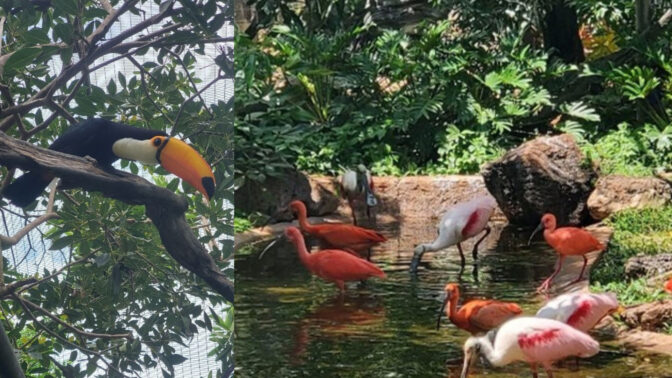By Staff Reports
(WAIKĪKĪ) – The Honolulu Zoo is pleased to announce the arrival of four vibrantly colored birds to the South American bird habitat. One toco toucan and three scarlet ibises were brought in from the Phoenix Zoo/Arizona Center for Nature Conservation to breed with their magnificent female counterparts.
Toco toucan
A male Toco toucan named “Guinness” will be paired with the Honolulu Zoo’s resident female toucan, “Tutu,” to breed. First, Guinness needs to reach maturity, which will happen at about three-to-four years old. Right now, Guinness is nearly one year old. The toucans occupy a corner space at the Diamond Head end of the South American bird habitat near the front entrance of the zoo.
Toco toucans are the largest species of toucans. They are native to South America and are noted for their distinctive black body and white feathers around their throat, chest, uppertail and undertail areas. They weigh around two pounds and can grow up to 25 inches long.
A toucan’s distinctive beak accounts for approximately one-third to one-half of its total body length, but contributes to less than three percent of the toucan’s weight, allowing it to fly. Their bills also have serrated edges so they can peel fruit like papayas, grapes and bananas. However, the main function of their signature beak is thermoregulation; the beak acts as a “heat sink,” distributing heat away from the bird’s body through its beak, much like elephants do with their ears and dogs do with their tongues.
Industries including architecture, transportation, and protective equipment are studying the toucan’s biological structure to utilize in manmade designs through a practice called “biomimicry.”
Scarlet ibises
The three new male scarlet ibises range in age from one-to-11 years old. The Honolulu Zoo’s wildlife experts are hoping that “Larry,” “Moe,” and “Curly” will be able to breed with the eight females already living in the South American bird habitat. To attract a female, male birds will perform mating rituals which include popping of their bills, shaking, head rubbing and preening. Females will lay a clutch of three-to-five eggs which incubate for 19-to-23 days. With the addition of these new birds, there will now be four total male scarlet ibises at the Honolulu Zoo.
Scarlet ibises are noted for their brilliant orange-red color and have black wing tips. They primarily come from tropical South America and are medium-sized waders, approximately two-feet long. Scarlet ibises spend most of their time on foot, wading in water and use their long, thin bills to feed and probe for food like small fish, crickets and mealworms. The scarlet pigmentation of their plumage comes from their high consumption of red shellfish and other foods which produce astaxanthin.
Both toco toucan and scarlet ibis species have a lifespan of approximately 20 years.

